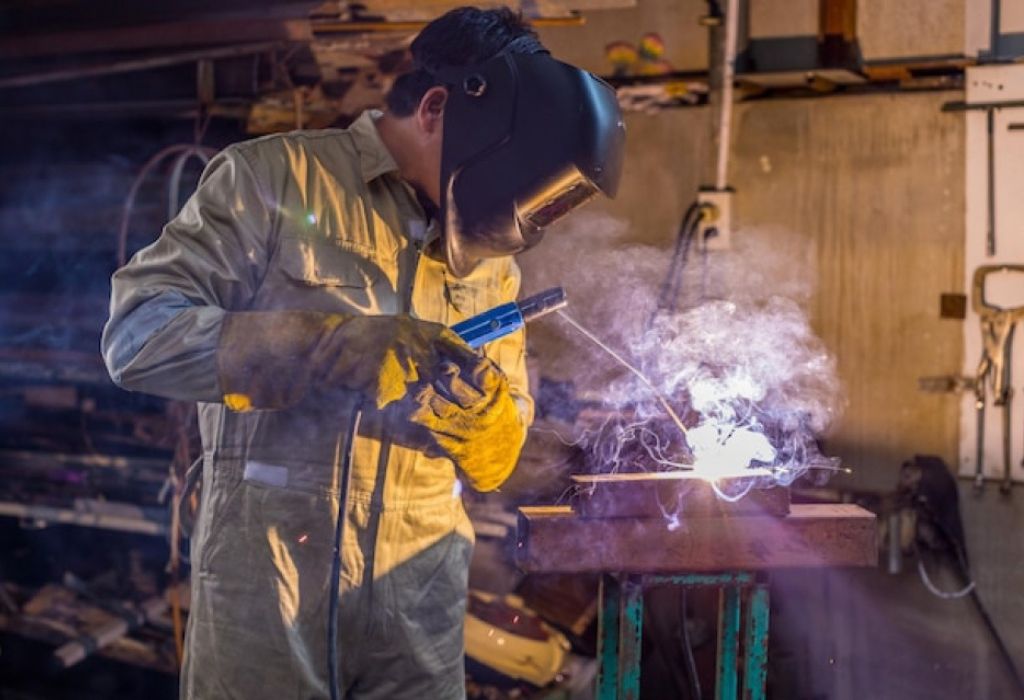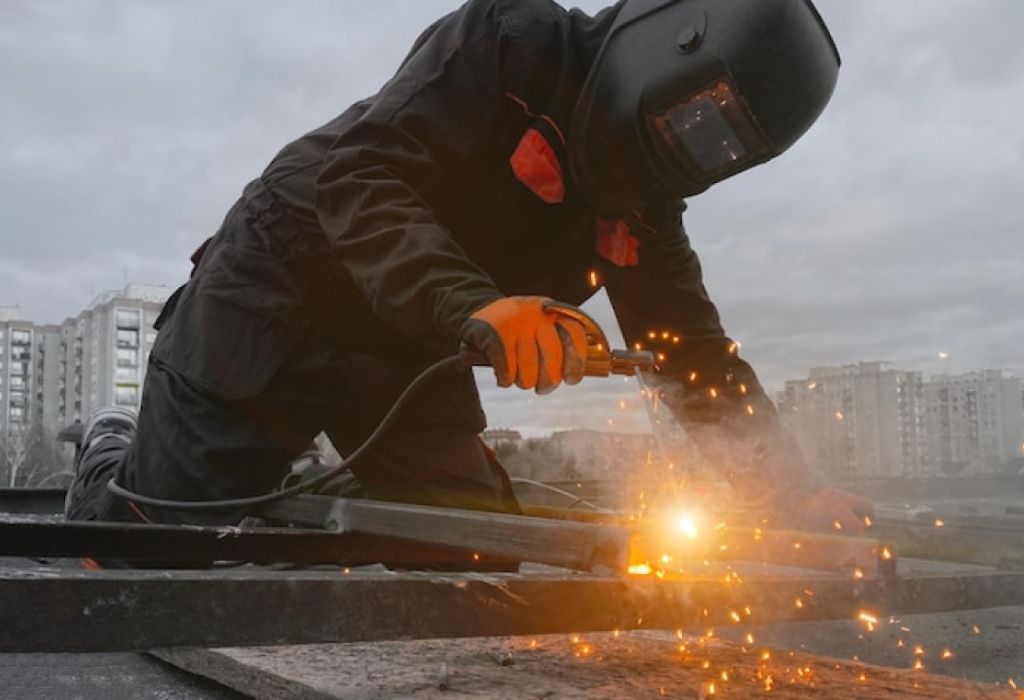A recent graduate from a welding program steps into a busy fabrication shop in Columbus. Sparks fly around the work floor, but one question burns brighter than the arc: how much does a welder make in Ohio today?
Pay is one of the most important concerns for anyone starting in the trade. A steady paycheck means stability, but the amount can vary greatly by skill level, certifications, and even the city where the work is done.
A new hire in a small town may earn less than a union welder in Cleveland or a pipe welder on a construction site.
Welding remains one of the most in-demand trades in Ohio. According to the U.S. Bureau of Labor Statistics, welders across the United States earn a median annual wage of about $51,000 (source).
In Ohio, job postings and labor market reports show hourly averages ranging between $21 and $24, depending on city and employer (source).
The gap between entry-level and specialized welders can be wide. Certified welders, pipe welders, and those working overtime on big industrial projects often earn far above the state average.
This means opportunities to grow income are real for anyone willing to develop their skills.
This guide explores every detail of welder pay in Ohio, from statewide averages to city-specific wages, union benefits, and the impact of certifications.
By the end, readers will understand not just what the numbers look like, but also how to move up the pay scale in one of Ohio’s most vital industries.
Quick Answer — Average Welder Pay in Ohio (2025 snapshot)

Welders in Ohio typically earn between $21 and $23 per hour, depending on experience, location, and the type of work. That translates to an annual income of about $44,000 to $48,000 for a full-time schedule.
This average places Ohio welders close to the national median wage of $51,000, reported by the U.S. Bureau of Labor Statistics. While pay is slightly lower than the U.S. median, Ohio’s cost of living is below the national average, making wages more competitive in real terms.
Union welders, pipe welders, and those working on specialized industrial projects often earn above the statewide average. These roles may pay $30 or more per hour, especially when overtime or per diem benefits are included.
Job postings show a consistent demand for welders across cities like Columbus, Cleveland, and Cincinnati. Employers in heavy manufacturing, automotive, and construction continue to raise pay to attract skilled labor.
What is the average welder pay in Ohio today?
Around $21–$23/hr statewide depending on city and role.
What does that equal per year?
Approximately $44,000–$48,000 annually for full-time work.
How does this compare to the U.S. median?
Slightly lower, but close to the $51,000 national median wage.
What’s the typical range for most welders?
Between $17.80 and $23.60/hr for the majority of Ohio welders.
Is pay trending up?
Yes, employers are increasing wages as skilled labor shortages continue.
Pay by City — Cleveland, Columbus, Cincinnati and More
Pay differs significantly depending on where a welder works in Ohio. Metropolitan hubs generally pay more than small towns due to industry demand and union influence.
Cleveland and Columbus currently show averages around $24 per hour, among the highest in the state. Cincinnati sits slightly lower but still near the statewide average.
Smaller cities and rural areas often offer less, but specialty industries such as shipbuilding or pipeline work can raise wages sharply. Local demand plays a huge role in setting pay.
How much in Columbus?
Around $24.18/hr, according to recent job postings.
How much in Cleveland?
About $24.20/hr average across listings.
What do statewide postings show?
An Ohio average near $22.30/hr.
Do suburbs or port areas differ?
Yes, marine and refinery jobs often pay more.
Are rural rates lower?
Yes, unless specialized projects drive demand.
Role Matters — Entry-Level, Certified, Pipe, and Union
Not every welding job pays the same. Roles requiring certifications or specialized skills command higher wages.
Entry-level welders may start closer to $17–$19/hr, but certified welders often reach $21–$22/hr. Pipe welders, due to skill and risk, frequently earn $30/hr or more.
Union welders enjoy structured pay scales, benefits, and pensions. Non-union jobs may offer higher base rates but fewer long-term benefits.
What is entry-level welding pay in Ohio?
Often around $18–$20/hr depending on location.
What do “certified welder” roles pay?
Averages near $21.86/hr in Ohio postings.
Pipe welder rates?
Typically $30+/hr in industrial and pipeline projects.
Union welder pay?
Around $21.16/hr statewide, with higher total compensation packages.
Do traveling welders make more?
Yes, per diem and travel pay can push earnings above $50/hr.
Annual vs Hourly — How to Convert and Compare Offers
Understanding annual vs hourly pay helps welders evaluate opportunities. A $23/hr role equals about $47,800 per year based on a standard 40-hour week.
Overtime can add thousands annually, and per diem jobs can double take-home pay on big projects. Always calculate full compensation, not just hourly rates.
Benefits matter too. Health coverage, retirement contributions, and union pensions add long-term value.
How to compare a $24/hr shop job to a $30/hr travel job?
Calculate annualized income plus per diem to see the difference.
Does overtime change everything?
Yes, consistent OT can add $5,000–$10,000 yearly.
How do benefits factor in?
They increase total compensation significantly.
What’s the best way to benchmark?
Compare against BLS data and live job postings.
Are salary sites consistent?
No, so use multiple sources for accuracy.
Industries Hiring in Ohio and Typical Pay Bands

Ohio’s industries drive welder wages. Automotive manufacturing, heavy equipment, energy, and construction are key sectors.
Pipe welding and pressure vessel work typically pay the most. Fabrication and production welding provide steady but mid-range wages.
Sanitary TIG welding for food and medical industries also pays premiums for skill and cleanliness.
Which sectors pay the most?
Pipe, refinery, and construction shutdown projects.
Which sectors are steady but mid-range?
General fabrication and manufacturing lines.
Are robotic welding operators different?
Yes, machine operators follow separate wage scales.
Does certification change industry access?
Yes, it opens higher-paying opportunities.
Do sanitary TIG roles pay more?
Yes, due to technical demand and industry standards.
Credentials That Move the Needle
Certifications and advanced skills often raise wages quickly. Employers reward welders who can pass difficult tests.
AWS D1.1 structural certification, ASME IX, and 6G pipe tests are among the most valuable. TIG skills on stainless and aluminum are also in high demand.
Multi-process welders who master stick, MIG, TIG, and flux-core gain access to more jobs. This flexibility often leads to higher pay.
What single skill bumps pay fastest?
Consistently passing 6G pipe tests.
Is multi-process worth it?
Yes, it widens career opportunities.
Do schools and apprenticeships pay during training?
Yes, with step raises as skills improve.
Are robotic welding skills valuable?
Yes, automation knowledge commands a premium.
Which soft skills count?
Safety, speed, and reliability matter as much as welding.
Cost of Living and Why $24/hr in Cleveland ≠ $24/hr Everywhere
Wages must be viewed alongside cost of living. A $24/hr job in Cleveland may stretch differently than the same pay in rural Ohio.
Housing, transportation, and utilities can make urban wages feel tighter. Rural jobs may pay less, but expenses are also lower.
Per diem jobs can help balance high travel or lodging costs. Union benefits also add value beyond base pay.
Is higher city pay always better?
Not if cost of living is higher.
Do per diem jobs stretch dollars?
Yes, stipends increase take-home pay.
How to compare offers quickly?
Use annualized pay and cost-of-living calculators.
Will union benefits offset lower base pay?
Often yes, especially with healthcare and pensions.
Should new welders chase big metros?
Start where growth opportunities are strongest.
Breaking Into the Trade in Ohio

Becoming a welder in Ohio requires training, practice, and persistence. Many start through community colleges, technical schools, or union apprenticeships.
Apprenticeships provide wages while learning. Bootcamps and technical schools can prepare welders for immediate entry-level work.
Networking with union halls or employers helps secure higher-paying roles. Building a portfolio of test plates and certifications proves ability.
How long to employability?
Bootcamps may place welders within months.
First jobs to target?
Fabrication or production welding for experience.
When to test for pipe?
After mastering x-ray quality welds on plate.
How to prove value on day one?
Be punctual, safe, and consistent.
Where to watch pay trends?
Monitor local postings and union wage sheets.
Future Outlook — Automation, Materials, and Wage Growth
The future of welding in Ohio is tied to industry growth. Infrastructure projects, manufacturing, and energy will drive demand.
Automation is growing, but skilled welders remain essential for complex tasks. Those who adapt by learning programming or robotics secure strong roles.
Materials like stainless steel, aluminum, and high-alloy metals will stay in demand. Specialized TIG welders can expect premium pay.
Will robots take welding jobs?
They will assist, not replace, skilled welders.
What materials are hot?
Stainless, aluminum, and high-strength alloys.
Where might wages climb?
Shutdowns, pipelines, and specialty TIG work.
Is certification evergreen?
Yes, renew and add to stay competitive.
What’s the best hedge for the future?
Be versatile and ready to travel.
Conclusion
How much does a welder make in Ohio depends on city, role, and skill set. Statewide averages sit around $21–$23/hr, equal to $44,000–$48,000 per year.
Pipe welders, union members, and specialized TIG welders often earn far more, sometimes above $30/hr. With overtime and per diem, total packages can reach $50/hr equivalent.
The future looks bright for welders in Ohio. Demand continues across industries, and those who invest in certifications and multi-process skills will see higher pay and better opportunities.
For anyone starting the trade, the lesson is clear: master the basics, pursue certifications, and position yourself in industries with the strongest wages. With focus and skill, Ohio welders can build not only a solid income but also a long and rewarding career.

I’m Darrell Julian, the founder, lead writer, and hands-on welding enthusiast behind ArcWeldingPro.com. With more than 15 years of real-world welding experience, I created this platform to share what I’ve learned in the field, in the shop, and in the heat of the arc.


